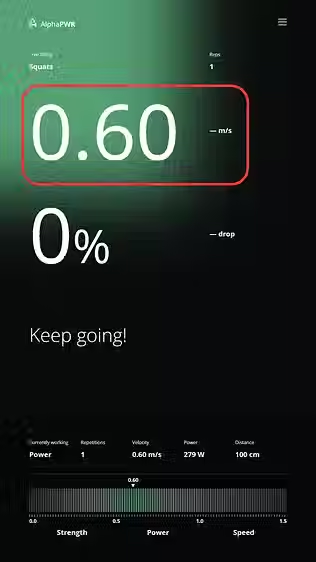Squat - workout screen
- Rostyslav Yena
- Aug 16
- 2 min read
This article is meant to go a bit deeper into the specifics of our squat screen than the main introductory page does. Like many parts of our system, basic usage is simple for anyone, but for those looking to dive into the rabbit hole, we'll show you the way!

The Squat Workout Screen is specifically engineered to enhance your exercise experience by providing immediate, insightful feedback during your squat sessions. This dynamic display offers an array of essential data that empowers users to stay focused, make informed adjustments, and optimize their performance in real time. With the Squat Workout Screen as your training companion, you can confidently elevate your fitness goals and achieve greater progress.

Lifting velocity
AlphaPWR can accurately measure the lifting velocity of a user without attaching anything to the barbell. This is made possible by using physics to calculate the movement of the center of mass during a squat. The velocity value is displayed as a number in the upper left corner of the Workout Screen.
Measured in units of m/s, velocity is tracked throughout the concentric phase of the lift. On the Workout Screen, AlphaPWR presents the mean propulsive velocity, which is calculated by averaging the velocity from the start of the squat to its peak velocity.

Velocity drop
The Velocity Drop feature tracks users' performance by measuring the percentage decrease in velocity from their fastest squat repetitions. It works with the Traffic Light System, changing color based on proximity to the preset velocity drop threshold.
Users can customize or use the default velocity drop settings based on their training preferences. By adjusting the desired velocity through the remote control, the Traffic Light System adapts to users' personalized preferences, providing an efficient workout experience.

Distance
AlphaPWR accurately assesses squat depth by tracking the vertical displacement of the center of mass during the squatting motion. By monitoring this crucial metric, users can receive real-time feedback to optimize their squat form and ensure consistent depth across all repetitions. It is essential to note that the center of mass is influenced by the added weight during the exercise. Consequently, to achieve comparable squat depth results, users should maintain a consistent weight load throughout their workout sessions, whether it is their body weight or additional resistance.

Power
Users receive real-time feedback on the power generated during each squat repetition. The power metric displayed on the screen is calculated by multiplying the peak velocity of the center of mass with the total mass and the gravitational constant on Earth. Since power generation is not necessarily linear with weight, this valuable information assists users in identifying the optimal weight for their body to produce maximum power.

Repetitions
AlphaPWR's intelligent rep counting feature allows users to fully concentrate on their workout without the distraction of manually keeping track of repetitions.

Velocity zone
AlphaPWR enables users to customize their workout focus—strength, power, or speed—by working out with maximum intent and lifting weights at the highest possible velocity. The on-screen bar displays the target training quality, which can be adjusted by adding or removing weight from the barbell. Increasing weight shifts the focus towards strength, while reducing weight emphasizes speed. This adaptability offers a tailored training experience, helping users optimize workouts and progress towards their fitness goals.






Comments